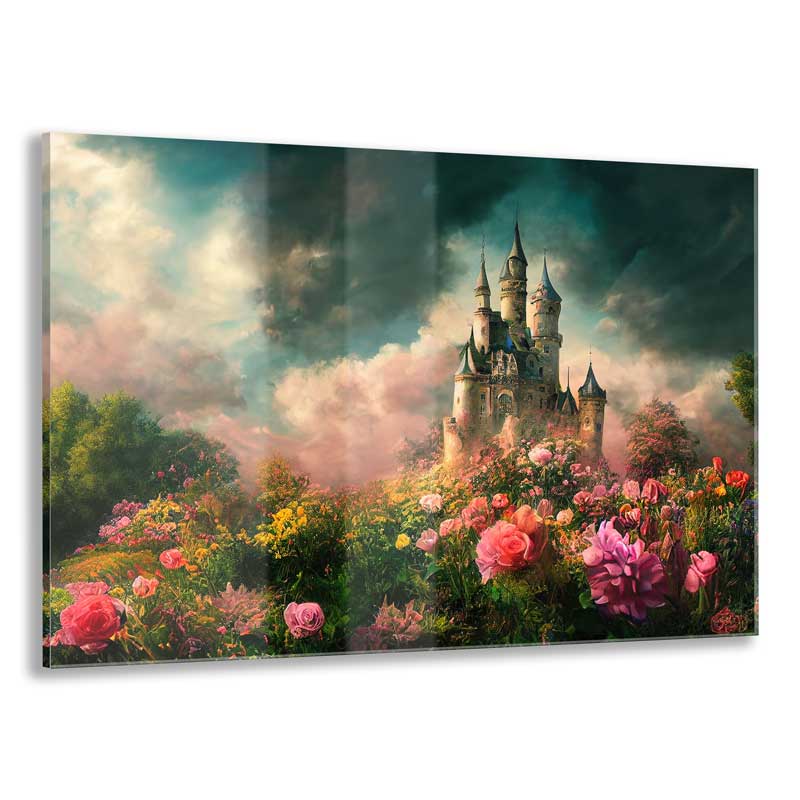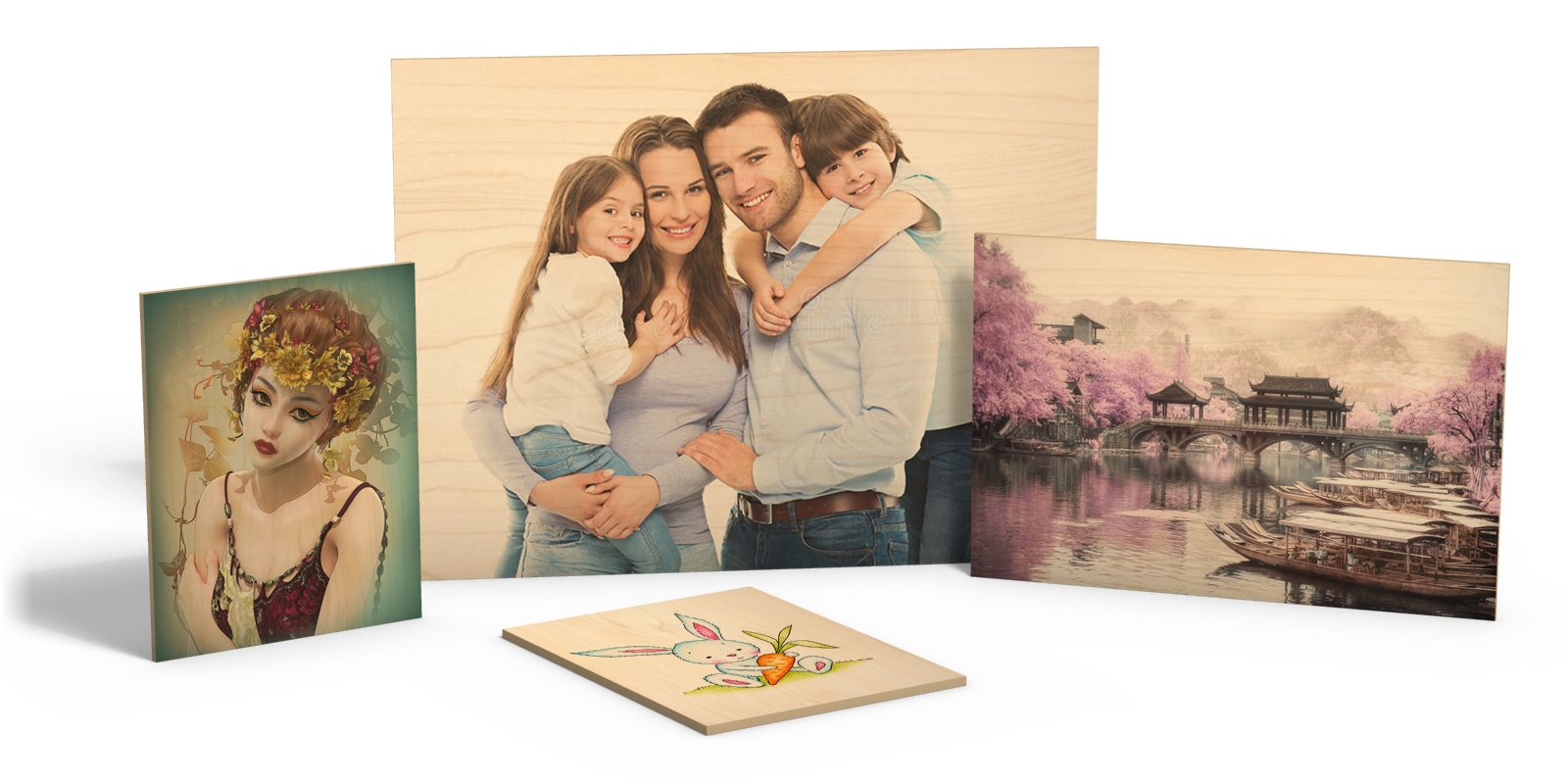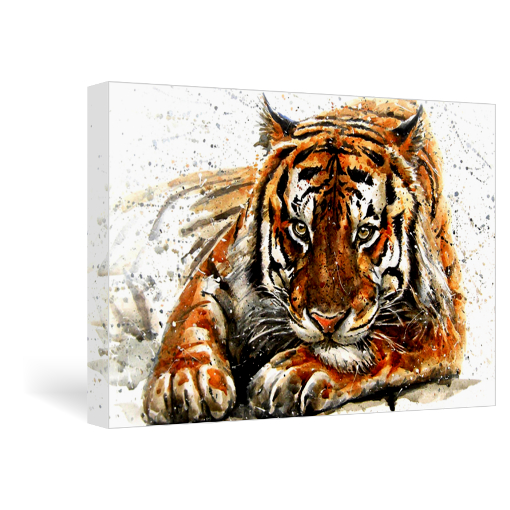We have been producing wood prints for a while now. We recently made some changes to a maple wood veneer panel. The new prints allow us to produce a superior quality product which is more durable and has greater image saturation and detail. Our natural wood maple panels, are ready to display. The back of the panels includes a pre-cut keyhole, so it will hang flush on any wall.
At a little more than ½” thick these panels are an ideal choice for many applications and settings without the need to be framed. The refined natural wood sides give it that finished look you require. With wood prints your image is sublimated / fused directly onto the surface. It allows for incredible detail to show while also having the wood grain look required. The surface can be dusted or even cleaned with a soft damp rag without danger of scratching or harming the image. But even with these improvements some of the same practices apply to produce the best wood print possible.
A this time we have about 8 very popular sizes. These range from 5×7 which are perfect for a table top display to 30×40 which is ideal over any large wall space. You can see and order these at the following link:
So, how do you know if your image will look good on wood or not? All the images we initially tested and made into our new wood prints have looked fantastic! But we have seen some images really stand out above others. It has nothing to do with the image quality of the artwork or the photography. It has to do with the tones in the image. Fortunately we have invested a lot of time in testing the process which allows me to share with you what we have learned. If that is not enough, our print setup tool attempts to simulate a wood print before you order it so you can get a bit of a preview to help you decide.
Let’s first look at what really helps a photograph or artwork take advantage of the wood textures and grains that you want to show in your wood print. Images with a lot of whites or lighter colors will work best if your desire is to show the wood pattern. Images where you have darker tones may start to cover up the natural wood texture so if it it has black or really dark colors, you may not see the wood pattern very well.
The reason lighter colors show the wood pattern better is because the way printers work. With some exceptions, most printers don’t print with white ink. At least this is the case in the photo and art printing world. Rather than printing white, these printers rely on the whiteness of the paper the image is being printed on. A classic example is when you print a gray-scale image such as black and white photograph. With that black and white you can sometimes get a warmer tone to the print on certain papers over others if the paper you are making your print on is too off-white. First you won’t have any pure whites because the wood is not white. But this is what we want to make a wood print in the first place. We want the the hue of the underling wood with the natural wood pattern to be visible to some extent. Keep this fact about whites in mind with wood prints. Even though we are not printing direct to wood but instead sublimating and image to it via heat and pressure, any whites in the image don’t transfer.
As previously mentioned, where you loose the ability to show some of this potential wood hue and natural wood pattern is with an image that may have a lot of dark colors. For instance, when we were first testing the development of wood prints, we produced a number of test prints using various imagery from our stock imagery and staff created collections. It allowed us to see how different types of images would look. One particular image was an abstract art piece. The tones tended toward either deep red, browns and blacks with a few hi-lights in yellow and white. White the print came out looking really nice it did not really show the underlying wood. Because of that I would have probably been better off just printing it on one of our fine art papers and then mounting it on masonite.
So what kind of images look great on wood? Here are some examples of what I think looks really good:
- Photos and portraits taken with lots of light
- Illustrations or line drawings
- Artwork on pure white backgrounds (my favorite)
- Paintings with bright colors
Photo and portraits taken with lots of light
These give the photo a very vintage look. If this is of interest to you, you will notice the image takes on a somewhat sepia tone. Not completely but just enough of a hint. Because the wood is somewhat yellow in color, you colors are influenced by this yellow tone.
Illustrations or line drawings
These look incredible. It gives the artwork a look as if it was created directly on the wood itself. While making an interesting piece to frame or display, we are already seeing what we suspect are artists intending to simply use these as under paintings which they will later hi-light or paint over with actual paints.
Artwork on pure white backgrounds (my favorite)
Think of say a flower by itself with white in the background. Or a seashell which one customer just did the other day. It looked really incredible. The artwork was centered on the wood print but the white background was not visible. I could see a series of wood prints done displaying various subject matter.
Paintings with bright colors
A good example of on our site is a faerie sitting on a log in a forest. The background sky was a very light shade of color so the natural wood texture coincidentally looked like clouds. Again, you want the wood to show up so if you have too many dark colors, you won’t be able to take advantage of this as intended.
The bottom line is any image can look good on wood but if you want your wood pattern to show up make sure you have images with a good balance of brights, mid-tones and darks. Artworks and photos that best take advantage of the underlying wood patterns will have lots of lighter colors.
Now if this is not enough information for you how about simulating the entire wood print process. It is actually quite easy with a program like Photoshop. We will have to do a video tutorial later on this but for those somewhat versed in Photoshop or Photoshop Elements simply locate or even create a wooden like pattern, complete with a small amount of yellowish hue. Then drag the image you want to print on top. This should create a layer over your wood background. Set this image layer as “multiply” and it will make your lighter tones turn translucent so the wood pattern underneath shows. Use this to get a general idea because each wood panel will be a little different from each other.
A couple things I want to point out to the very color conscientious. Let’s be realistic. If you are after that specific shade of blue, orange or green that you spent hours trying to tweak and get right on your screen, you won’t necessarily get it in a wood print. A wood print is not going to be accurate because the wood being printed on can vary. While we currently only offer birch hardwood, slight variations in it’s natural hue will occur. While I am not an expert, I know this can be attributed to things such as the age of the wood and even where the wood originated. So if you tend to get hung up on colors, don’t with wood prints since you can never predict how the underlying wood will will affect the color. Finally on a similar note, you can’t soft proof a wood print. Soft proofing relies on a white point of the paper or media the image is being printed to. Since we can’t create a color profile with a consistent white point on wood, it is impossible to provide you one.
Hopefully this will give you some insight on wood prints. If you want to test the concept out with your artwork or photography, feel free to start off with something small. I will be surprised if you are disappointed. Be sure to let us know what you think of your wood prints when you get them so we can share your own insights with others.
Wood Prints FAQs
Canvas Prints
A giclée print is a way to classify a professionally produced print using inkjet technology; primarily printed on canvas or fine art paper with archival-grade inks. While the process is only several decades old, it has quickly become the method of choice for both artists and photographers. Read more…

Order HD Face Mounted Acrylic Prints
Printed on high quality photo paper and face mounted to 1/4″ acrylic with polished edges. Choose between satin luster or metallic photo paper. Included is easy to install hanging hardware in the form of a French cleat.
The following items arrive ready to hang:
- framed prints
- stretched & mounted canvas
- wood prints
- acrylic prints
- metal prints (with the exception of some styles)
- wall art standouts
Order HD Chromaluxe® Metal Prints
Print your artwork or photography as custom-size metal prints. Using the dye-sublimation process, your image is fused to the surface of rigid aluminum panels. These provide a modern look when decorating your home or office. Choose from multiple metal surface options. Order it framed, with a float wall mounting or even with a tabletop easel back.
Yes. Many artists order their under-paintings from us.
Giclee Printing at FinerWorks
One of the largest ranges of paper selections, while using the highest level of archival print technology allowing superior detail and color, you can create custom giclee prints of your artwork and photos.
Our canvas prints are produced with new resin inks. The resin-coated pigments acts as a built-in liquid coating for each inkdrop which alleviates the need to apply any sort of liquid coating or laminate like done in the past. This allows for greater image details and consistency across print-to-print.
Order Giclee Printing on Canvas
Printed using some of the highest archival standards in the industry, your photos or artwork will last for decades to come.
Samples can only be ordered from our parent company FinerWorks. To access these go here.

Order HD Face Mounted Acrylic Prints
Printed on high quality photo paper and face mounted to 1/4″ acrylic with polished edges. Choose between satin luster or metallic photo paper. Included is easy to install hanging hardware in the form of a French cleat.
For canvas, we primarily use poly-cotton blend canvases, specially coated to receive the inks used by our printers. The canvas has an oxford weave giving it a natural canvas texture as favored by professional photographers.

Order HD Face Mounted Acrylic Prints
Printed on high quality photo paper and face mounted to 1/4″ acrylic with polished edges. Choose between satin luster or metallic photo paper. Included is easy to install hanging hardware in the form of a French cleat.
Both Epson and Canon promote their inks as being resistant to fading over time. Over time we have used both wide-format printers from both companies. Our parent company FinerWorks has been producing canvas prints since around 2001. In that time, we have had no one contact us and indicate their print had faded.
Order HD Chromaluxe® Metal Prints
Print your artwork or photography as custom-size metal prints. Using the dye-sublimation process, your image is fused to the surface of rigid aluminum panels. These provide a modern look when decorating your home or office. Choose from multiple metal surface options. Order it framed, with a float wall mounting or even with a tabletop easel back.
Your giclee canvas print will last up to 150 years with the proper care. Both Epson and Canon promote their inks as being resistant to fading over time.
Order HD Chromaluxe® Metal Prints
Print your artwork or photography as custom-size metal prints. Using the dye-sublimation process, your image is fused to the surface of rigid aluminum panels. These provide a modern look when decorating your home or office. Choose from multiple metal surface options. Order it framed, with a float wall mounting or even with a tabletop easel back.
Yes. We use only sap-free lumber for our stretcher bars. Our preference has always been Kiln dried pine as it is not likely to crack, warp, or become brittle.
Giclee Printing at FinerWorks
One of the largest ranges of paper selections, while using the highest level of archival print technology allowing superior detail and color, you can create custom giclee prints of your artwork and photos.
Giclee Printing at FinerWorks
One of the largest ranges of paper selections, while using the highest level of archival print technology allowing superior detail and color, you can create custom giclee prints of your artwork and photos.



